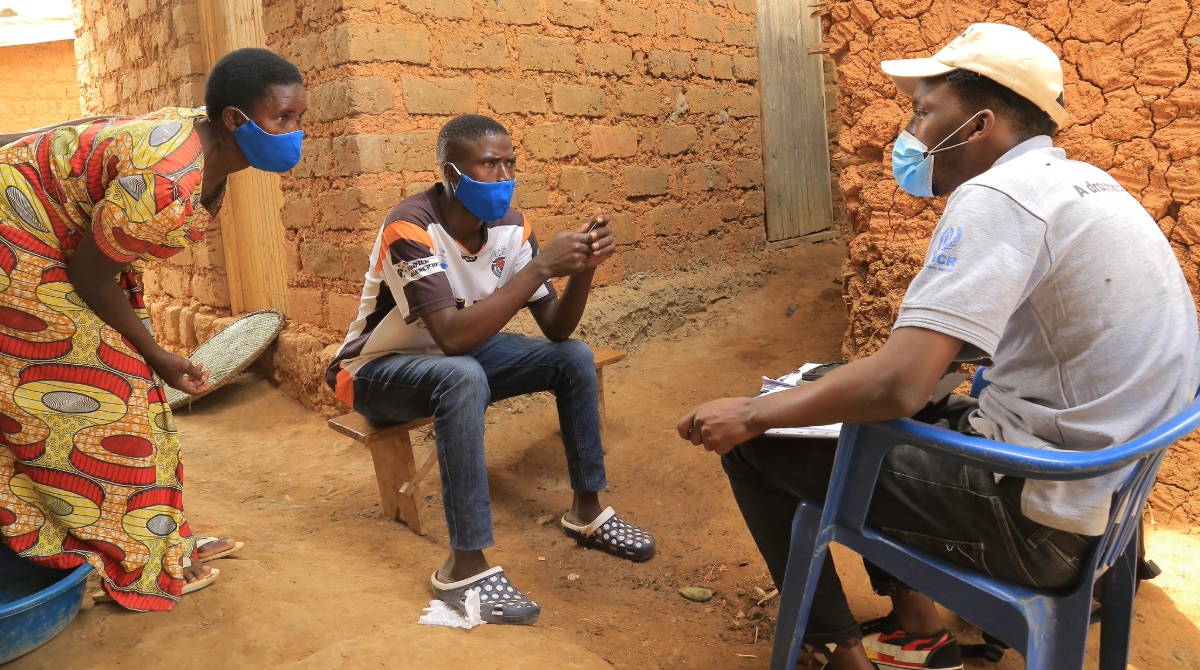At a glance
This story describes Uganda's progress in controlling the HIV epidemic using data from the Uganda Refugee Population-based HIV Impact Assessment (RUPHIA) survey. It also discusses how CDC worked with country-based partners to support this initiative.

Background
*Story originally published in 2023.
Data from the Uganda Refugee Population-based HIV Impact Assessment (RUPHIA) survey show progress towards controlling the HIV epidemic. For example, HIV is only prevalent in 1.5 percent of people aged 15 years and older living in Ugandan refugee settlements. RUPHIA also found that people living in Ugandan refugee settlements are making strong progress towards targets for controlling the HIV epidemic.
These targets are set by the Joint United Nations Programme on HIV/AIDS (UNAIDS) and state that:
- 95 percent of people living with HIV (PLHIV) should be aware of their status.
- 95 percent of those aware of their status should be on antiretroviral treatment (ART).
- 95 percent of those on ART should achieve viral load suppression.
In fact, among survey respondents in 2021:
- 82 percent of adults living with HIV were aware of their status.
- 90 percent of adults aware of their status were receiving ART.
- 93 percent of adults on ART were virally suppressed below detectable levelsA.
The survey also shows that more than seven in ten PLHIV in these settlements had achieved viral suppression. This was separate from whether they knew their HIV status or not. These findings indicate that PLHIV in these settlements are aware of their status, receiving treatment, and achieving viral suppression. However, additional effort is still needed to find and link more PLHIV to treatment to accelerate progress toward ending HIV.
PHIA vs. RUPHIA
Population-based HIV Impact Assessments (PHIAs) are national surveys implemented under the Ministries of Health, U.S. President's Emergency Plan for AIDS Relief (PEPFAR), CDC, and partners. These surveys directly measure progress toward global targets for ending the HIV epidemic. RUPHIA, conducted from October to December 2021, sought to measure the impact of the HIV response. This included accounting for the prevalence of HIV and viral load suppression among adults living in Ugandan refugee settlements. Of the 1,250 eligible households, more than 93 percent completed a household interview.
RUPHIA is the first household survey of its kind to assess the impact of HIV treatment and prevention services within Uganda's refugee settlements. CDC commends all partners in this effort which has provided valuable data for improving programs designed to treat and prevent HIV infections in Uganda's refugee settlements.
- Dr. Lisa Nelson, CDC Uganda Country Director
Ugandan refugee settlements
Uganda is home to more than 1.5 million refugees. This makes it the third-largest refugee population in the world and the largest in sub-Saharan Africa. Ugandan refugee settlements house refugees and asylum seekers mostly from South Sudan, Democratic Republic of Congo, and Burundi. Nearly 80 percent of the asylum seekers and refugees are women and children who co-exist with the communities that host them. Conflict and displacement make women and children, particularly girls, disproportionately vulnerable to HIV.
Refugees often face stigma due to their refugee status. Additionally, they face stigma because of the common misconception that HIV prevalence is higher among refugees than host communities.1 However, RUPHIA data show an HIV prevalence of 1.5 percent among adults living in Ugandan refugee settlements. This rate is lower compared to the 5.8 percent prevalence reported for Uganda's general population in UPHIA 2020.

CDC's impact
CDC Uganda has supported HIV treatment and prevention services in Ugandan refugee settlements since 2017. This was made possible through partnerships with the College of Health Sciences, Makerere University's Infectious Diseases Institute (IDI) and Baylor Uganda. These partners support multiple initiatives that are a part of the country’s Refugee Response plan.
For example:
- Monitoring for HIV cases at border crossings and refugee settlements.
- Linking clients to HIV treatment.
- Providing a safe and reliable system for transporting lab samples.
Today, nearly 2,500 refugees are currently receiving ART through CDC- and IDI-supported health facilities. Furthermore, there are now over 25 health care facilities accredited to provide ART and TB services in Ugandan refugee settlements. These facilities are also all connected to the national laboratory network system.
Acknowledgements
RUPHIA was led by the Government of Uganda (GOU) through the Ministry of Health (MOH). It also received funding from PEPFAR and technical assistance from CDC. The survey was implemented by ICAP at Columbia University and MOH in collaboration with other GOU entities including the:
- Uganda Virus Research Institute.
- Office of the Prime Minister.
- Uganda Bureau of Statistics.
- United Nations High Commissioner for Refugees (UNHCR).
- These findings are based on a denominator of between 25 and 49 participants and should be interpreted with caution.
- HIV and Refugees policy brief. UNAIDS, UNHCR. https://www.unaids.org/sites/default/files/media_asset/jc1300-policybrief-refugees_en.pdf
